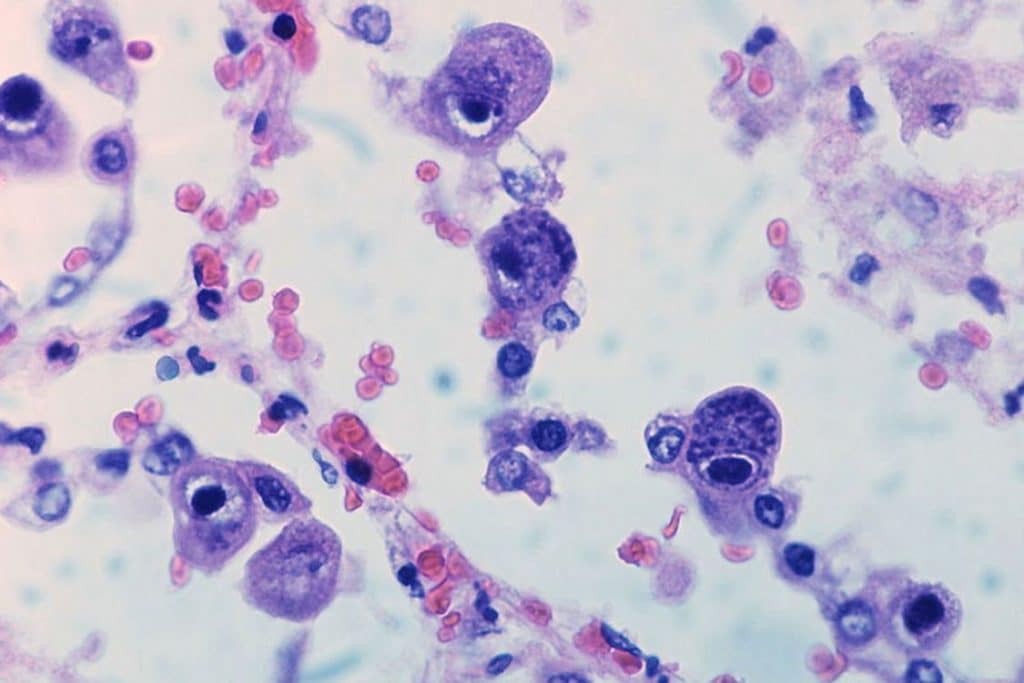Features of the course of cytomegalovirus infection in women and methods of its treatment
The most common infection today is cytomegalovirus. Symptoms in women can occur both mildly and completely absent, which can be explained by the latent course of the disease. If the human immune system is strong enough, infectious agents do not pose a threat to the body. Otherwise, especially with an existing immunodeficiency or after a transplant, cytomegalovirus can cause dangerous complications.

Cytomegalovirus in women, when it enters the body, causes a chronic infectious disease. For the most part, there are no manifestations of infection as such, but it is not uncommon for there to be pronounced symptoms. The main reason for the entry of foreign agents into the body of a woman is considered to be a weakened immune system. At the same time, he is no longer able to fight penetrating infections, allowing them to gain a foothold in internal organs and systems. Unfortunately, people of any age are susceptible to the disease.
The primary entry of the virus into the body of a woman occurs from the direct carrier of this infection. A secondary disease is caused by exposure to a certain external or internal factor that negatively affects the protective function of the immune system. The root causes can be:
- transmission of infection to the child during labor or in the prenatal period;
- the virus enters the body when a sick person coughs, sneezes or kisses;
- infection as a result of a transfusion of infected blood to a healthy person;
- sexual intercourse with a sick partner is another reason for transmission.
An active course of cytomegalovirus infection can be caused by such provoking factors as the concomitant development of a cancerous tumor, HIV infection or AIDS, and pathologies of the digestive tract. Anticancer drugs and antidepressants that a person takes can also “awaken” the virus.
Symptoms of an acute form of the disease

CMV (cytomegalovirus infection) is accompanied by symptoms that vary from person to person depending on the form of the disease. In most cases, a latent course is diagnosed, in which pronounced symptoms do not appear before exposure to a provoking factor. In this case, there is an acute form of the disease. Some people have severe damage to the internal organs, which characterizes the generalized form of the pathology.
The acute form of cytomegalovirus disease has similarities with infectious mononucleosis. Its onset is abrupt, with a rise in general temperature and a febrile syndrome. In addition to these symptoms, the first signs of pathology are the defeat of the lymph nodes, during which they increase in size. Their soreness, increased softness and elasticity are also noted.
At stage 1 of the development of acute cytomegalovirus infection, cervical lymph nodes are involved in the lesion. Following them, the submandibular, axillary, inguinal ones increase. It is lymphadenopathy that is the first sign of the disease and the last in its disappearance. Other symptoms of this condition include headache, general malaise, hepatomegaly (an increase in the size of an organ such as the liver), atypical mononuclear cells in the blood.
The main difference between cytomegalovirus infection and mononucleosis is the absence of tonsillitis in the first case. The occipital lymph nodes and spleen are also rarely enlarged.
Symptoms of a generalized form of the disease

This form of the disease manifests itself quite rarely, but with the development of severe symptoms. Basically, generalized cytomegalovirus infection in women occurs against the background of immunodeficiency or other infection. In the first case, the preceding factor may be chemotherapy or radiotherapy, and in the second, HIV infection. The generalized form of the disease can occur in conjunction with damage to internal organs, blood vessels, nerves, and salivary glands.
Development of cytomegalovirus hepatitis and pneumonia
Hepatitis with cytomegalovirus is accompanied by the involvement of the cells of the organ and blood vessels in the pathological process. In this case, the development of inflammatory infiltration and necrosis occurs. Dead cells are shed and enter the bile duct, clogging it and causing stagnation. As a result, jaundice, the main symptom of which is the yellowness of the skin. There is also general malaise, nausea and vomiting.
At the beginning of the development of a generalized cytomegalovirus infection, the occurrence of interstitial pneumonia is observed, which is accompanied by damage not to the alveoli, but to their walls, capillaries and tissue around the vessels. Treatment of this type of pneumonia is difficult, which explains its long course. In some cases, bacterial infections are attached with the following symptoms: a significant increase in general temperature, febrile syndrome, cough with sputum, a feeling of lack of air.
Development of cytomegalovirus retinitis and sialadenitis
A disease such as retinitis is accompanied by damage to the retina. Both eyes are involved in the pathological process. Retinitis occurs with the following symptoms: photophobia, clouding and goosebumps.
With sialadenitis, the salivary glands, especially the parotid glands, are affected. In this case, there is an increase in the overall temperature, the occurrence of a shooting pain syndrome in the affected area, a decrease in salivation and dryness in the oral cavity.
The development of cytomegalovirus nephritis and diseases of the reproductive system
The inflammatory process in the kidneys develops in such areas of the organ as tubules, capsule, glomeruli. In addition to the kidneys, the ureters and bladder may be involved in the lesion. Renal failure develops quite quickly, which is accompanied by the appearance of a sediment in the urine, including epithelium and cytomegalovirus cells.
Perhaps the development of cervicitis, endometritis, salpingitis - those pathologies that are chronic. In this case, there is such a symptom as periodic, unexpressed pain in the lower abdomen, which manifests itself in the process of urination and during sexual intercourse.
Features of the course of cytomegalovirus infection in women with AIDS
According to numerous studies, 9 out of 10 women with acquired immunodeficiency syndrome are also infected with cytomegalovirus. Such patients often suffer from bilateral pneumonia, which occurs in conjunction with lung tissue damage. Such a concomitant disease is characterized by a protracted course with the occurrence of a painful cough and shortness of breath. Another symptom of cytomegalovirus in women with AIDS is encephalitis, the complications of which are dementia, decreased memory and attention.
The nervous system is also involved in the lesion. Polyradiculopathy often develops - a disease that is characterized by damage to the nerve roots, general malaise and pain in the lower extremities. Cytomegalovirus infection in women with AIDS also occurs with the involvement in the pathological process of such organs as:
- kidneys, with the subsequent development of acute nephritis, etc.;
- liver, with the occurrence of hepatitis, jaundice, liver failure, etc.;
- pancreas, with the development of pancreatitis, etc.;
- eyes, with the occurrence of retinitis, retinopathy, etc .;
- organs of the genitourinary system, with the further development of cancer of the cervix, endometrium, etc.
The treatment regimen for cytomegalovirus in such cases is determined by the attending physician. Often it is the cytomegalovirus infection that occurs in women with AIDS that is the cause of death.
Treatment

Treatment of cytomegalovirus in women, first of all, consists in taking antiviral chemotherapeutic drugs, the active components of which contribute to the inhibition of the DNA polymerase of the virus.
Chemotherapy is prescribed, as a rule, if the disease proceeds in a generalized form, when the retina or lungs are involved in the pathological process. Such drugs have increased toxicity, which does not allow their use during pregnancy. The impact of chemotherapy drugs on the human body causes a negative effect on such an organ as the kidneys.
Contraindications to the use of chemotherapeutic agents are: low hemoglobin (less than 80 g / l) and platelet levels (less than 250 thousand * 10¹² g / l), the development of severe renal failure. Side effects may also occur, for example, such as impaired functioning of the liver, kidneys, the occurrence of seizures, candidiasis, ataxia.
Interferons are considered other drugs used in the treatment of cytomegalovirus infection. During the life of such a virus, leukocytes in the blood weakly produce natural interferon, which is the reason for its replenishment with the help of drugs. The most common of these are: Viferon, Cycloferon, Genferon. The advantage of such drugs is the limited amount of side effects.
Another drug for eliminating cytomegalovirus infection is the hyperimmune human immunoglobulin Cytotect, which contains antibodies to the virus. The drug can be used even during pregnancy. Despite such a great effectiveness of the drug, it can cause side symptoms: headache and joint pain, nausea, vomiting, anaphylactic shock, hypotension. The main contraindication to taking the drug is individual intolerance to its components.
How to prevent infection of the body with cytomegalovirus
How to treat cytomegalovirus, found out. It is worth mentioning the methods of prevention, because if you take all preventive measures, you can significantly reduce the risk of pathology. For this reason, the following recommendations are recommended:
- Limiting contact with sick people with cytomegalovirus infection.
- Systematic ventilation of premises, including industrial and public, where there is a mass congestion of people.
- Preventive examinations of women both during pregnancy and at the planning stage, even if there are no pronounced symptoms.
- Blood test of donors for the presence of cytomegalovirus infection.
And, of course, the most important rule for disease prevention is a timely visit to the doctor, at the first alarming symptoms.



